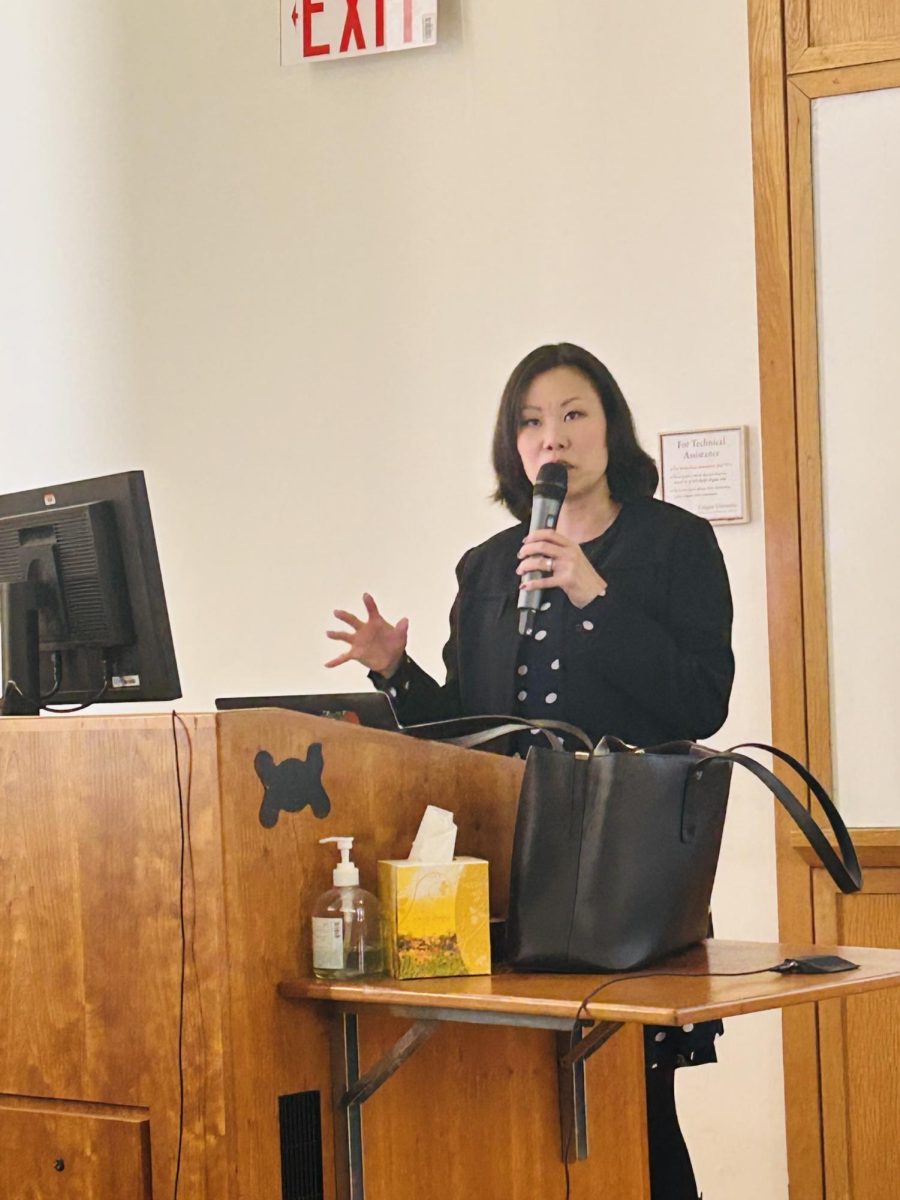Associate Professor of Political Science Bruce Rutherford provided a comprehensive overview of the conflict in Gaza to students and faculty on Feb. 7. The lecture, which drew a full house at Colgate University’s Persson Auditorium, was the second part of a series Rutherford presented, with the first — on Jan. 31 — covering the histories of Israel and Palestine that led to today’s reality. The lecture series is a collaborative effort between the Jewish studies and Middle Eastern and Islamic studies (MIST) programs that aims to bring in a unique speaker once a week for the rest of the semester.
“We very purposefully tried to emphasize that this is a collaboration between Middle Eastern and Islamic studies and Jewish studies, [and] that these academic ventures can collaborate and cooperate in very constructive ways. In fact, if you want to understand this part of the world, these perspectives need to be in dialogue with each other,” Rutherford said.
First-year Micah Spicer attended the event for a class and further developed an interest in the topic.
“I definitely learned a lot. I wasn’t super aware of the build-up leading to the war, so I feel more informed on that aspect,” Spicer said. “I definitely will attend more events [like this] because I am not super educated about the topic and would like to learn more about it.”
Rutherford presented his lecture chronologically, beginning where he left off last week with the 1948 Arab-Israeli War and explained many key terms used in current discourse as he went. The overall format allowed Rutherford to both explain history and possible future complications in the region.
“In 1948, many refugees [from the war with Israel] went to Gaza — some say 70 percent of the population of Gaza is either people who fled [after the 1948 war] or their descendants,” Rutherford said. “One of the continuing topics of dispute in the Arab-Israeli conflict is whether those refugees who fled [after 1948] have any right to return to their homes — this is called the ‘right of return.’ This is a continuing point of debate for both sides and would almost certainly have to be resolved for the Arab-Israeli conflict to genuinely be settled from the standpoint of the Palestinians.”
One aspect Rutherford went in-depth on was the Oslo Accords, which were a set of peace agreements from the 1990s, as the United States is currently creating new peace plans based on the Oslo formula. By explaining where Oslo went wrong, Rutherford hoped to shed light on issues with the U.S.’s plan as proposed by current Secretary of State Anthony Blinken.
“The Oslo peace agreements were premised on Palestinian recognition of Israel’s right to exist and Israel recognizing limited Palestinian autonomy in the West Bank and Gaza — on a practical level, granting local Palestinian authority over day-to-day activity in the territories under their control,” Rutherford said. “It is worth noting that Israel did not recognize a Palestinian state, but the expectation on the Palestinian side was that this would be moving towards a Palestinian state.”
To junior Simon Khairallah, the history of the peace talks was an interesting aspect of the talk.
“I [attended] because I was interested in learning more about the context of the current war in Gaza and the historical events that set the stage for the conflict,” Khairallah said. “I learned more about Secretary Blinken’s plan to use the conflict to pursue a peace settlement and broader reordering of regional powers to ensure Israel’s security.”
Rutherford then explained how the religious perspective in Israel changed since the Oslo peace process failed in the early 2000s, referencing themes of Zionism and religious obligation explained in his initial lecture.
“This religious perspective — that Jews have not just a right but a duty to live in the West Bank — has strengthened since the end of the Oslo process,” Rutherford said. “In the current Israeli government, there are several senior ministers who are very committed to this idea — including the national security minister, who is the minister responsible for security forces in the West Bank. It will be difficult to persuade Jews with this religious perspective to accept a Palestinian state.”
Rutherford also covered political developments in Palestine, including the election of Hamas in Gaza, which has become a contested topic of debate.
“Hamas’ charter in 1988 made clear that its goal was the destruction of Israel, and that goal has not changed,” Rutherford said. “When Hamas won 45 percent of the vote in the 2006 elections in Gaza, the big question was whether their supporters were endorsing this ideology. The prevailing interpretation was that most of the people who voted for Hamas were casting a protest vote against Fatah. Fatah had been the prevailing power in Gaza up to that point, and it was deeply corrupt and incompetent. […] Voters believed that Hamas was more honest and would run Gaza more competently and with less corruption, and that it would improve the quality of life on the ground.”
The care Rutherford took in explaining both sides of the conflict stood out to many attendees.
“I appreciated how Professor Rutherford handled the lecture by presenting both sides of the conflict and affording attendees the opportunity to voice any issues they had with his remarks,” Khairallah said.
Before holding a question-and-answer session, Rutherford concluded his lecture by explaining where Gaza stood before the Oct. 7 attacks.
“Ever since Israel began a blockade of Gaza in 2007, their goal was to ensure that Hamas didn’t develop greater military capability. But on a practical level, the blockade meant that Gaza never developed economically,” Rutherford said. “Gazans were surviving, but they were not growing economically. A young person in Gaza didn’t really have much of a future — the most he or she could hope for was to survive, not to have a career or have any hopes or ambitions. Israel also adopted very sharp limits on Palestinians’ ability to leave Gaza — the phrase that you often heard in the Arab world in this period was that Gaza became an ‘open-air prison.’ In other words, you had 2.2 million Palestinians fenced into this fairly small area with little opportunity for a better life. […] This produced a feeling of hopelessness among many residents of Gaza.”
Finally, Rutherford provided context for the Oct. 7 attacks in the scope of the world and of Israel specifically.
“In terms of the number of people killed, this is the third largest terrorist attack in modern history,” Rutherford said. “The figure that I think is really important to understand and appreciate from the Israeli perspective is the number of victims as a percentage of the nation’s population.”
In his two-part lecture series, Rutherford provided a comprehensive and unbiased history of both Israel and Palestine to equip students with the context of how the conflict got to this point. Rutherford’s background gave students the knowledge needed to appreciate the forthcoming lectures in the series held by MIST and Jewish studies.














